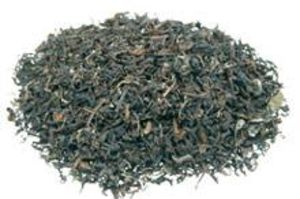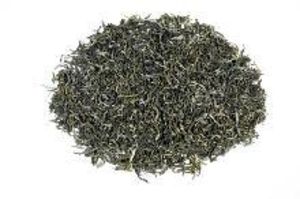Tea Varieties
We stock 140 different varieties of tea in our shop which can be categorized into the following kinds of tea.
Rooibos Tea
Rooibos bushes solely grow in South Africa and are members of the legume family. Originated from the western mountaineous regions of the South African province Western Cape they now mainly grow in the Cederberg region, around 200 km north of Capetown.
Here they find ideal conditions like rough, sandy soils, and the rains during winter supply enough water.
Seed-planting times are the months of February and March; seedlings are planted in plantations in July. The first harvest will be after one to one and a half years.
Now for five years Rooibos can be harvested regularly during the months of December to April. Then the plants are replaced by new seedlings.
As Rooibos tea does not contain any caffeine or teina, it can be enjoyed any time during the day or night. The quercetine it contains, a yellow natural dye, can even effect vascular dilatation and lower blood pressure. Rooibos is also effective against the formation of cancer, arteriosclerosis and Alzheimer's disease.
Rooibos also includes vitamin C, carotenoids and flavonoids which act a part in fighting many diseases. They can help in cases of skin problems like eczema, neurodermatitis and sunburn. Rooibos also contains magnesia, calcium, phosphates, iron as well as fluorine which is important for hardening of teeth.
Other ingredients are responsible for the tea's antispasmodic and anti-inflammatory effects - ideal in cases of gastrointestinal complaints. Furthermore anti-allergic effects can be achieved, for example in cases of hay fever. And its high level of minerals makes Rooibos tea an ideal thirst quencher for sportsmen.
Fruit Tea

Ingredients of our fruit tea are being cultivated in all parts of the world. Through incorporating different fruits our teas gain their unique fruity but still spicy taste, using for example rosehip, apples, orange and lemon peel, elderberries and cherries.
Most cultivation areas of ingredients are located in tropical and subtropical regions. Depending on the seasons fruit teas differ in their composition.
As fruit teas can be complex and can widely differ in their ingredients they have different effects on the body and on wellness. In general they are very healthy for people of all ages because they contain many essential vitamins and minerals. Especially teas low in acidity are gentle on the stomach and thus suitable for children and teenagers. Fruit teas support the body in many ways, for example they strengthen the immune system, stimulate the digestive system, help with circulatory complaints, exhaustion and colds-related symptoms (rhinitis, coughs, hoarseness).
Herb Teas

Ingredients for herb teas often come from cultivation areas like Egypt, China, South America and Germany. Quantity and quality of the harvest are dependent on climatic, soil and weather conditions. The harvest season differs due to enviromental influences and plant variety.
Plants used in herb teas have various constituents. Among these are essential oils which determine taste and smell of each plant, as well as vitamins, minerals, trace elements and polyphenols (pat of the secondary phytochemicals).
Herb teas are low in calories and perfect for meeting the needs of your daily liquid requirements. With the exception of a few varieties they are free from caffeine.
Like fruit teas they have supporting and vitalizing effects on the human body due to the many essential vitamins and minerals they contain. Among others herb teas for example strengthen the immune system, stimulate digestion, help with circulatory complaints, exhaustion and colds-related symptoms.
Green Tea
 This kind of tea has been cultivated in China for several thousand years. In the sixth century B.C. this new variant in processing tea was created here.
This kind of tea has been cultivated in China for several thousand years. In the sixth century B.C. this new variant in processing tea was created here.
In 780 A.D. poet Lu Yu described this in great detail. In the same century Buddhist monks brought the tea (Matcha) from China to Japan.
Lu Yu's work initiated a new form of preparing tea. During the Tang dynasty, the tea, pressed to form bricks or other forms, was ground to powder und then brewed with boiling water.
This procedure was then refined during the following Song dynasty - directly after steaming and drying them, the tea leaves were put into stone mills. This is the origin of the traditional tea ceremony still common in Japan.
During the Ming dynasty in the 16th and 17th century, tea was brewed with hot water without grinding it beforehand - the preparation method still used today. Around this time green tea spread in Europe, too.
Oolong Tea
 Oolong originally meant "black dragon" or "black snake". Oolong is a traditional Chinese tea which for centuries now is said to have healing qualities. It is also supposed to be beneficial for weight loss.
Oolong originally meant "black dragon" or "black snake". Oolong is a traditional Chinese tea which for centuries now is said to have healing qualities. It is also supposed to be beneficial for weight loss.
The taste of Oolong lies somewhere between green tea and black tea. Oolong uniquely combines the full aroma and the delicious taste of black tea with some of the best health benefits of green tea.
Oolong is a semi-fermented tea. This means that the tea leaves were exposed to a fermentation process which was stopped again after a short time.
This tea stimulates the nervous system and increases metabolic processes. For a while it was marketed as an "old Chinese secret for losing weight".
White Tea
 White tea, one of the sic Chinese teas, owes its name to white, silk-like down fluff which encloses its young buds.
White tea, one of the sic Chinese teas, owes its name to white, silk-like down fluff which encloses its young buds.
Its quality is reached mainly by choosing the right leaves: only the unopened leaf buds of the tea bushes, cultivated in the South Chinese province Fujian, are used for especially high-grade varieties like Yin Zhen. For the production of one kilogram of white tea around 30,000 hand-picked buds are needed.
This variety of tea gains its mild taste by using gentle air- and light-drying methods. Not least because of its high content of polyphenol white tea is said to have beneficial effects on human health. Polyphenols are supposed to be highly effective anti-oxidants which destroy free radicals and thus strengthen the immune system. And according to the Chinese, it also has the effect of lowering blood pressure.
Black Tea
 After picking the tea leaves they are air-dried and then rolled up. After rolling them up, the leaves are fermented at a temperature around 30 degrees Celsius until they change their colour to a copper-red hue. The leaves are then dried at 85 degrees for 20 minutes and are then sorted by size.
After picking the tea leaves they are air-dried and then rolled up. After rolling them up, the leaves are fermented at a temperature around 30 degrees Celsius until they change their colour to a copper-red hue. The leaves are then dried at 85 degrees for 20 minutes and are then sorted by size.
Cultivation areas of black tea are the tea tree regions, among others in Africa, Ceylon, South America and India. Harvest time for first flush teas are the end of March to the beginning of May. Second flush harvest begins in the middle of May and ends at the beginning of July.
This tea can lower blood pressure, calms the nerves and furthers concentration abilities.





